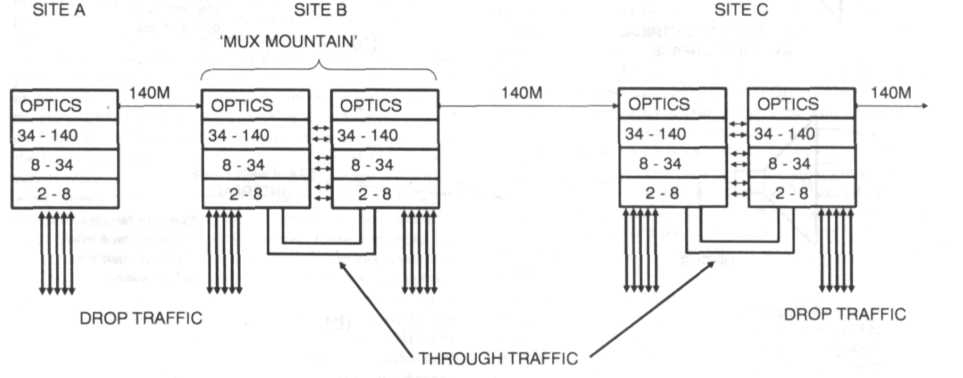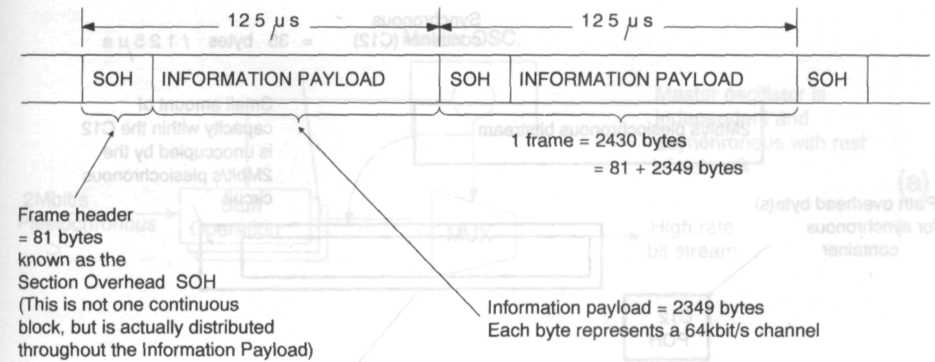
- •42 The Synchronous Digital Hierarchy (sdh)
- •42.1 Introduction
- •42.2 Pdh deficiencies
- •42.3 The basis of sdh
- •42.3.1 The concept of pointers
- •42.4 The sdh standards
- •42.4.1 Path OverHead information
- •42.4.2 Multiplexing of Virtual Containers
- •42.4.3 Channels and Tributary Unit Groups
- •42.4.4 Vc4 Into a Synchronous Transport Module
- •42.4.5 Further use of Pointers
- •42.4.6 Other sizes of vCs and payloads
- •42.4.7 Sonet and sdh
- •42.4.8 Nni Optical Interface standardisation
- •42.4.9 Sdh network elements
- •42.5 Control and management
- •42.6 Sdh based networks
- •42.6.1 Sdh network topologies
- •42.6.2 Deployment strategies
- •42.7 Impact of broadband standards
- •42.7.1 Frame Relay
- •42.7.2 Switched Multimegabit Data Service (smds)
- •42.7.3 Fibre Distributed Data Interface (fddi)
- •42.8 Future technologies
- •42.8.1 Integrated circuits
- •42.8.2 Optical interfaces
- •42.8.3 Optical amplifiers
- •42.8.4 Optical switching
- •42.8.5 Memory and processing power
- •42.9 Conclusion
42.2 Pdh deficiencies
In order to fully appreciate SDH, it is useful to briefly examine some of the limitations of the PDH. These limitations fall under three main headings:
1 Lack of flexibility. It is more difficult, using PDH based equipment, to drop and insert a low rate channel from a high rate channel, without the use of a 'multiplexer mountain'. The normal example given is that of dropping out a 2Mbit/s channel from a passing 140Mbit/s stream. (See Figure 42.1.) The cause of this particular problem lies in the amount of information processing necessary to locate and extract the required traffic channel. The basic PDH multiplexing process involves a bit interleaving operation which obscures knowledge of the individual byte boundaries, and thus leads to an inflexible system This inflexibility extends beyond drop and insert functionality, to crossconnects. These become rather large and cumbersome because the PDH restricts them to use only space switching, as opposed to the much more efficient Time-Space-Time techniques that SDH allows.

Figure 42.1 The difficulty of accessing a passing 2Mbit/s stream using PDH equipment
2 Lack of performance. The PDH does not currently have any internationally standardised ways of monitoring the performance of traffic channels at 8Mbits and above. Even at 2Mbit/s, where there is a mechanism (CRC4), it only works when the 2Mbit/s channel has a G.704 frame structure imposed on it. Furthermore, the PDH does not have any agreed management channels or protocol stacks etc. Although some of the spare bits in the frame alignment words can be, and already are, used to carry management information, the information capacity is somewhat limited (e.g.22kbit/s @ 34Mbit/s). Worse still, when operating at one of the higher order rates, the PDH makes it difficult to retrieve any management information associated with lower order channels, without a full demultiplexing operation. Finally, even at 2Mbit/s, there is no guarantee of any management information. The usual example here is that of the 2Mbit/s private circuit, leased to the customer as a clear channel i.e. the PTO imposes no G.704 frame structure and the customer has full control over the entire 2.048Mbit/s bandwidth. In this case, there is no room for the PTO to insert any monitoring or control information, hence it cannot tell when the performance of such a circuit drops out of specification. On the other hand, the customer has almost certainly imposed his own frame structure, and therefore can monitor the delivered performance with great accuracy.
3 Lack of 'Mid-Fibre Meet'. Although the PDH specifies the exact format of the bit stream at the aggregate port of any PDH multiplexer, it puts no such constraints on the hit stream on the line side of a line transmission terminal. (See Figure 42.2.) Consequently, every manufacturer has used his own proprietary line code and optical interface specification, making it impossible for a PTO to interconnect line terminals from two different manufacturers. This operational constraint is destined to because an increasing problem due to the progressive fragmentation of the erstwhile monopoly transmission networks into a patchwork of smaller operations, all of which need to interwork with each other. Without an agreed Mid-Fibre Meet standard, this interworking becomes rather clumsy, as both ends of an interconnecting line system have to be bought from the same manufacturer, and will probably need to be controlled as a pair, rather than independently by each operator. It is interesting to note that Mid-Fibre Meet was one of the original targets for the SDH standard, when it was first proposed in the US as part of the early work on SONET, back in 1984. (SONET, Synchronous Optical network, is the North American counterpart to SDH. It preceded SDH by some years.)
Of the above three problem areas, it is reasonable to suppose that (3) and to some extent (2) could have been solved by extensions and modifications to the existing PDH standards. In the future, though, it is likely that the sheer quantity of management information needing to be transported around a network, will eventually pose an insoluble problem for even a modified/extended PDH, hence any solution to this problem would always be viewed as a stopgap measure.
The problem of traffic path inflexibility is much more difficult to overcome by modifying the PDH. It is tempting to suggest synchronising an entire PDH transmission network, as many PTOs have already done at the 2Mbit/s level. Unfortunately, as well as being progressively more difficult to do at the higher bit rates in the PDH, synchronisation alone does nothing to preserve the byte boundaries within each bit stream. Without any easy method of identifying these byte boundaries, the task of extracting both low order traffic and management channels has not been significantly simplified. As a final nail in the coffin, strict network synchronisation also entails the addition of 'wander' buffers at every multiplexer, in order to accommodate slow variations in the inherent delay of the transmission media (usually optical fibres these days). These buffers themselves give rise to further undesirable transmission delays, which could push some PTOs towards the otherwise unnecessary adoption of costly echo cancellers on 64kbit/s circuits throughout their networks.

Figure 42.2 Comparison of interfaces needed in PDH and SDH environments: (a) current PDH; (b) SDH

Figure 42.3 The basis of SDH frame structure
